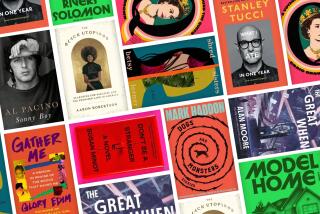Reading about the day the towers fell
Twelve years after the attacks that brought down the World Trade Center, the shelf of essential 9/11 reading remains pretty small.
There’s “The 9/11 Commission Report,” which I’ve long considered to be the defining narrative of the disaster (not to mention the greatest government commission report ever written), although for all its deft and nuanced sense of explication, it doesn’t tell us much about how things felt.
And, of course, there are dozens of works of reportage and fiction -- even Stephen King’s new novel “Doctor Sleep,” due out a little later this month, features its own small riff about the events of that September morning, as does Thomas Pynchon’s new novel “Bleeding Edge” -- but few have really encapsulated the weight, the magnitude of the tragedy.
As to why this is, Mona Simpson once suggested that it has to do with what we want from books; “After September 11,” she observed, “I didn’t read books for the news. Books, by their nature, are never new enough.”
After all this time, however, 9/11 is no longer news. For a while now, I’ve wondered if it has to do with a lack of perspective; think back to that day, after all, and tell me if you can make any sense out of what you saw.
I still remember turning on the television, where one tower stood shrouded in smoke, the second nowhere to be found. “Where’s the other building?” I asked, again and again, in pure cognitive dissonance, unable to process what was on the screen.
For this reason, perhaps, I’m compelled by the least digested representations of 9/11 because they reflect how I still feel. One such effort is “Here is New York,” a 2002 project put together by Gilles Peress, Michael Shulan, Charles Traub and Alice Rose George, which features something like 1,000 photographs -- by professionals and amateurs -- tracing the chaos of those first days and weeks.
Another is Art Spiegelman’s “In the Shadow of No Towers,” which grew out of a series of newspaper-style broadsides, 10 in all, that the “Maus” creator drew in the immediate aftermath of the towers’ fall. For Spiegelman, a longtime resident of lower Manhattan, 9/11 was personal: His daughter had started high school across the street from the World Trade Center days before.
His Sept. 24, 2001 cover of the New Yorker -- the black shapes of the buildings silhouetted against a slightly lighter background -- has become iconic, but in these over-sized comics, he moves away from that subtlety, from that nuance; reading them is like looking at the artist without his skin.
“I was sure we were going to die!” he recalls in one strip. “I’ve always sorta suspected it, but that morning really convinced me. ... My wife, my daughter and I are rushing from the bomb site. We hear a roar, like a waterfall, and look back. The air smells of death —”
As for his intentions, “[w]hen I was doing those pages,” he once told me in an interview, “I no longer believed that I was going to live long enough to make another book. By doing these Sunday pages, I could make something that was satisfying, while waiting for the other shoe to drop.”
That’s as good an explanation of why we make art -- any art -- as I’ve ever come across, and still I have to wonder: Why? Why, even now, do we seem largely unable to process 9/11 except through the filter of sentimentality or politics? Why have we tapped so sporadically into our loss, our incomprehension, our sense that there is chaos looming just beneath the surface of our daily lives?
“Those crumbling towers,” Spiegelman acknowledges, “burned their way into everyone’s brains, but I live on the outskirts of Ground Zero and first saw it all live -- unmediated.” This is what he captures so effectively, this notion of the primal, of what happens when our veneers get stripped away.
ALSO:
Art Spiegelman taps the source
Five essential books about 9/11
More to Read
Sign up for our Book Club newsletter
Get the latest news, events and more from the Los Angeles Times Book Club, and help us get L.A. reading and talking.
You may occasionally receive promotional content from the Los Angeles Times.








